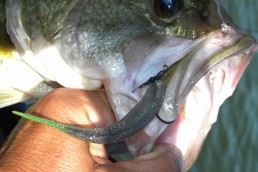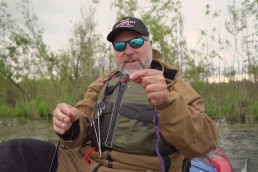Work-arounds When Bass Won’t Bite
SHARE THIS POST
Tussling with choosy bass happens more often than most of us would like, but there’s always some fish that are willing to bite when the right approach is used. The challenge, however, is finding the specific presentation to enchant a strike when fish are fussy. Adopting a problem-solving approach and systematically experimenting with different tactics are good strategies for triggering bass to bite.
Tinkering with tempo
Experimenting with different retrieve tempos is a good place to start, as speed is a triggering factor. Start with the mindset that it’s sometimes better to go faster. The rationale is that sprinting lures, like lipless crankbaits or spinnerbaits, let you cover water and increase the chances of contacting fish that can be triggered to strike.
The other end of the spectrum is that certain times a lazy retrieve is best. This is often most pronounced with crankbaits. Most die-hard cranking anglers use baitcasters with a low gear ratio (5.1:1) to crawl crankbaits and tease hits from inactive fish. A low-gear ratio reel causes a lure to wobble and wiggle in ways they won’t with faster reels, and this lethargic, roly-poly shuffle can make even a sluggish bass see red.

When “sprinting” and “slow” don’t work, a mid-range pace is the next option. Part and parcel of this approach is adding pauses to coax following bass to slurp up the lure.
Shake up the route
In a similar vein as retrieve speed, mixing up a lure’s trajectory is another trick. Change the angle of the rod during the retrieve by moving it from the left to the right side of your body. This maneuver can trigger a fence-sitting smallie or largemouth to lash out.
Intentionally making the baits come in contact with objects is another ploy for stimulating strikes. “Bumping the stump” is a common phrase referring to banging crankbaits, spinnerbaits or frogs off of logs, stumps, and other pieces of cover. Crashing a crankbait, or grinding a spinnerbait along the bottom, are other examples.
Going the distance
Long casts can make a difference in fooling fish. This is most important on clear-water lakes or those receiving lots of fishing pressure. Distance casts increase the space between the lure and the boat. The farther apart the two, the better your chances are of coaxing the skittish bass to chew. To maximize distance, I use a long rod, between 7 feet and 7 feet 6 inches. Casting with the wind is also a great way to get more line to fly off the spool.
Are you enjoying this post?
You can be among the first to get the latest info on where to go, what to use and how to use it!
The power of profile
There’s a lot to be said about the allure that a bait’s profile has when it comes to coercing bass. When bass are feeding on bottom-dwelling forage, like crayfish, using a bait with flailing pincher-like appendages can increase hook-ups. While baitfish—like shad or smelt—have a more streamlined profile, look to minnow baits, jerkbaits, and crankbaits to replicate this forage. And when gobies are on the menu, a stubby, big-headed bait is the way to go.
Vertical virtues
When dealing with bite-shy bass, a critical shift in strategy occurs when one switches from horizontal to vertical tactics. The reasoning behind this change is that active fish are more likely to chase horizontally moving lures. Inactive bass have a much smaller strike zone in comparison. Getting a bite can be done with a vertical approach and dancing a lure within their tiny strike zone. Jigs, blades, spoons and drop-shot rigs all have their place with this approach.
Think shrink
Another tactic when trouble-shooting picky bass is downsizing to smaller-than-average baits. This method has a knack to bring bass over my boat’s gunnels when all else fails. A main reason it’s so effective at getting lockjaw bass to chew is that the itty-bitty bait exudes “defenselessness” and portrays an easy snack.
There are lots of Lilliputian lures on the market between 2 to 3 inches in the jerkbait, crankbait, jig, spinnerbait and soft bait categories. Scrutinize hardware when using small lures. The bait’s design and components (hooks, split rings) should be stout enough to handle a scrap with a bass. Bear in mind that small, thin hooks stick easy, so don’t overdo the hook-set and use a steady sweeping motion.
Color considerations|
Pay attention to color when refining presentations, as the lure hue can be a deal-breaker for fussy fish. In clear water, natural patterns can outproduce loud paint jobs. Learn the local forage and duplicate these tones in offerings. Orange and green mimic perch and silver-sided crankbaits copy pelagic baitfish, while brown and olive imitate crayfish and other invertebrates. Hot colors have a place when fishing in stained water and can sometimes help trigger reaction strikes in many conditions.
Fishy fragrances
A bait’s smell deserves consideration. Tipping lures with scent-infused soft baits is one way to amp up a presentation’s olfactory appeal. When bass are picky, douse lures with fish attractant. This helps create a scent trail that attracts fish and stimulates them to bite. Moreover, scent masks unnatural odors.
It’s common to reminisce about non-stop fishing action. In reality though, these experiences are few and far between. And what’s more common is that fish are regularly in neutral to inactive moods. Fooling bass that aren’t actively feeding takes determination. The above techniques will tip the odds in your favor for bewitching them to bite.
MWO
SHARE THIS POST
Did you enjoy this post?
You can be among the first to get the latest info on where to go, what to use and how to use it!
Tim Allard
Tim Allard is a full-time outdoor journalist and author and photographer of the multi-award-winning book, Ice Fishing––The Ultimate Guide. Follow him on Instagram @timallardtips.



